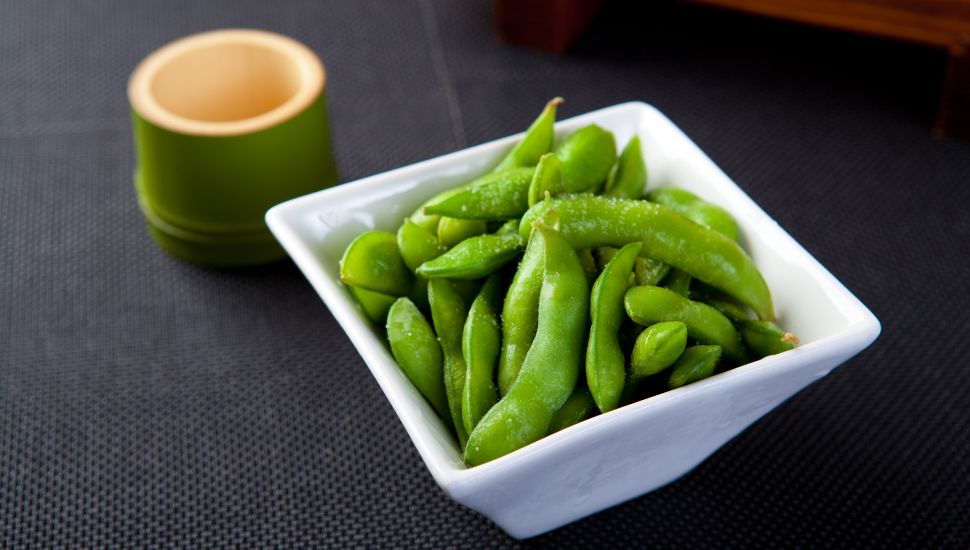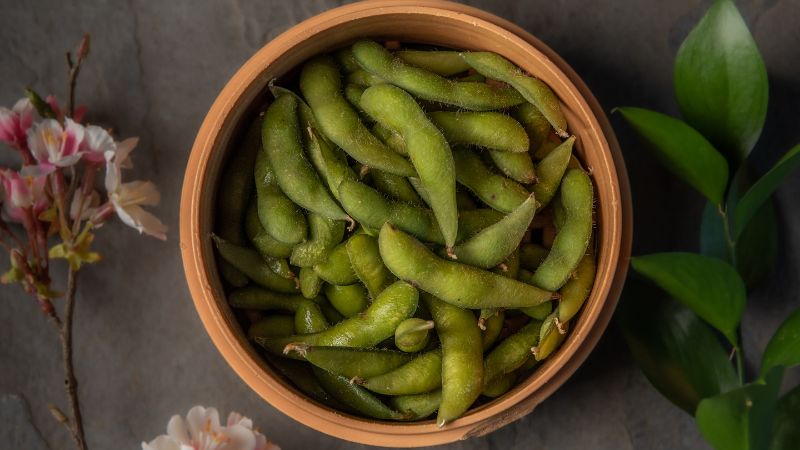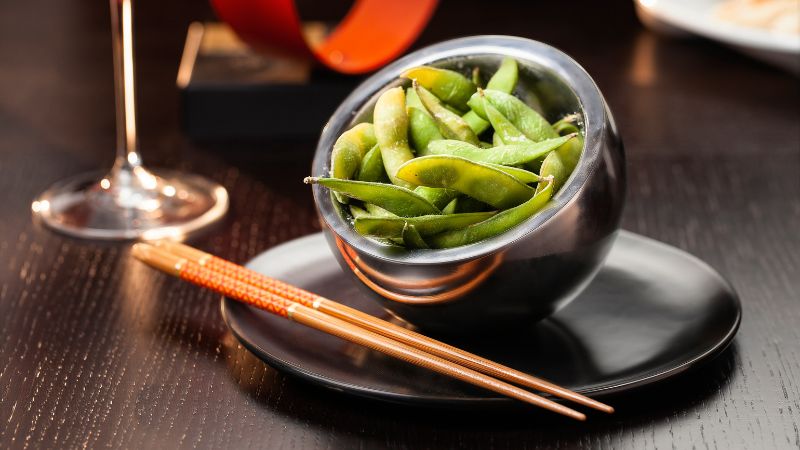
If you love to try exotic cuisines like Japanese, then you must love edamame. However, there must be some times when you see people using Mukimame and Edamame interchangeably.
And this might have confused you into wondering what exactly is mukimame and is of different or similar to edamame.
However, if you do know what these both ingredients are, and think that they are merely for starters in your favorite Japanese restaurant then you are going to be shocked after reading this blog.
Before we start, you should know that both mukimame and edamame are names of soybeans. The only difference between them is the time of harvest and their maturity.
Mukimame are Japanese for ‘stripped soybeans’ while edamame is Japanese for ‘stem beans’. They both come from the same tree but have slightly different taste.
What is Mukimame?
Mukimame is another name of Edamame. It is a nutritious legume that has gained popularity in recent years. These vibrant, green soybeans are harvested early, giving them a tender and slightly sweet flavor.

These versatile beans can be enjoyed in many ways, from being stir-fried and served as a snack to being added to salads and from pizza toppings to adding them in soup. Mukimame can be used in a lot of things.
Packed with protein, fiber, and essential nutrients, mukimame offers a healthy and delicious addition to your foods.
What is Edamame?
Edamame, a popular appetizer, and ingredient, is a type of young soybean harvested before they fully ripen. They originate from East Asia; edamame has become increasingly popular worldwide due to its delightful taste and nutritional benefits.
These vibrant green pods encase the tender, immature soybeans inside. Boiled or steamed, they are typically seasoned with salt, making them an irresistible and healthy snack.
Like Mukimame, they are also rich in minerals, proteins, and fiber and make every food nutritious when added. They can also be added to fast food items like pizza, pasta, and spaghetti.
What Do Edamame and Mukimame Taste Like?
Both edamame and mukimame share a similar taste; they have a slightly sweet yet delicate flavor. When cooked, these green soybeans have a tender yet slightly firm texture, satisfying every bite’s taste.
If you have never tasted them, you can think of their taste as fresh peas or young green beans but with a subtle nuttiness that adds depth to the overall experience.

Seasoned lightly with salt, the natural sweetness of edamame and mukimame shines through, making them an enjoyable and addictive snack.
Their mild flavor also allows them to easily take on the taste of other seasonings and sauces, making them versatile for various culinary creations.
More comparisons:
What are the Differences between Mukimame and Edamame?
Both the terms “mukimame” and “edamame” are used alternatively. However, there are some big differences that you should read about. Here are those differences.
Harvesting: The key difference is the harvesting time. Edamame is the young soybeans that are picked just before they fully ripen; this happens when they are still green and plump.
On the other hand, mukimame refers explicitly to the pre-shelled edamame, where the pods have been removed, leaving only the individual soybeans.
Preparation: Edamame is commonly found and enjoyed in its in-shell form. The pods are steamed and then seasoned with salt.
Eating edamame requires the diner to pop the beans out of the pods with their teeth or fingers, providing a satisfying experience.
Mukimame, being the pre-shelled version, saves you the effort of shelling and can be easily incorporated into various dishes without any additional preparation.
Availability: Edamame is more widely recognized and available in fresh and frozen forms. It is often found in Asian grocery stores and is a popular appetizer in Japanese cuisine. Mukimame, while less commonly known, can also be found in some specialty stores or as a frozen product.
Recipes: Both edamame and mukimame can be utilized in various culinary creations. In its pod form, edamame is also a popular snack at sushi bars and izakayas.
Mukimame, due to its convenience, can be easily tossed into pasta dishes, used as a pizza topping, blended into dips, or even incorporated into baked goods for added nutritional value.
Nutrition: When it comes to nutrition, both edamame and mukimame offer impressive health benefits. They both contain folate, iron, and even isoflavones (which protect your body from chronic diseases).
How to Prepare and Serve Edamame and Mukimame?
Preparing and serving edamame and mukimame is a simple and enjoyable process. You can cook them or add dishes in many other ways, so keep reading for ideas.
Cooking them: take a pot, fill it halfway with water, and add salt to it. Once the bubbles form in water (boiling), put your edamame beans in it and let them simmer for 10 minutes until they become firm. Drain and cool to stop from cooking.
For mukimame, since the pods have been removed, you can skin cooking and move directly to seasoning or incorporate them into your desired recipes. You can also boil them just like edamame if you want, but they are edible even without boiling.
Seasoning: The traditional and most common way to enjoy edamame is by sprinkling them with salt. However, you can add any spice you want to bring a twist to the dish.
Toss the cooked mukimame in your preferred seasonings, such as soy sauce, lemon juice, or a sprinkle of herbs, to enhance their taste.
Snack ’em’ up: Serve edamame or mukimame in their pods as a delightful snack or appetizer. Place a bowl of cooked and seasoned edamame on the table, and your guests can enjoy the interactive experience of popping the beans out of the pods and savoring their deliciousness. Provide an empty bowl or plate for discarding the empty pods.
Adding in other dishes: Both edamame and mukimame can be incorporated into various dishes to add texture, color, and nutrition.
Add them to salads for a vibrant crunch, stir-fries for a protein-packed element, or grain bowls for a well-rounded meal.
If you’re feeling cheeky, blend cooked mukimame into a creamy dip or incorporate them into baked goods like muffins or bread for an unexpected twist.
Final Verdict:
Both edamame and mukimame, the pre-shelled version of edamame, offer a delightful and nutritious addition to our culinary experiences.
They have a slightly sweet, mild flavor that pairs well with various seasonings and complements multiple dishes.
Additionally, edamame and mukimame are not only delicious but also offer health benefits. So, include them in your routine diet and enjoy the fantastic taste along with health.
FAQs (Frequently Asked Questions)
What is edamame called in India?
Usually, these beans are known as ‘mature soybeans’ or ‘green soybeans’ in India. Because of different cultures, people don’t call edamame as edamame.
What is an Indian substitute for edamame?
In India, the substitute for edamame is the famous green peas or, as Indians like to call, ‘Matar”. Green peas have the same color, texture, and even similar sweet taste (especially if they are young and not fully ripe).
What is special about edamame?
The versatility and the delicious taste of edamame are what make it so special and worthy food. Apart from this, edamame is also nutritious, making it a super healthy snack.
Is edamame a fruit or a vegetable?
Edamame is a vegetable and not a fruit. Since a vegetable is any edible part of the plant, and edamame is the seed of the plant, it classifies as a vegetable.







